Iliad › Mycenaean Pottery » Ancient origins
Articles and Definitions › Contents
- Iliad › Ancient History
- Mycenaean Pottery › Antique Origins
Ancient civilizations › Historical and archaeological sites
Iliad › Ancient History
Definition and Origins
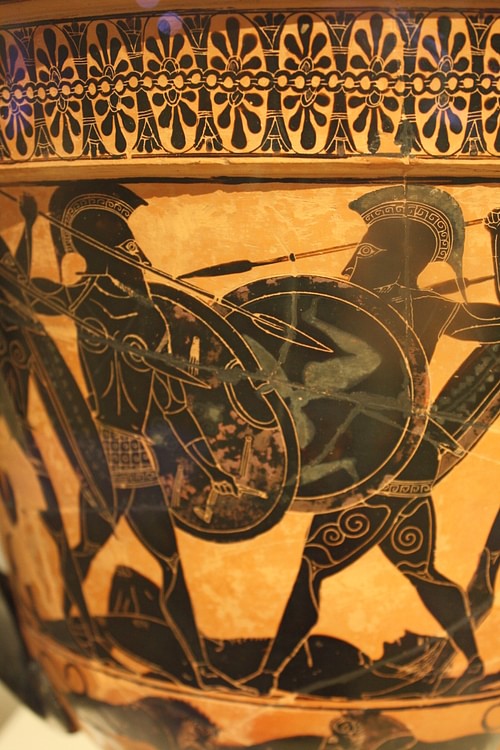
Homer 's Iliad describes the final year of the Trojan War, a legendary conflict between an alliance of Greek cities and the city of Troy in Anatolia. It was probably written sometime in the 8th century BCE after a long oral tradition, but the Greeks themselves imagined the war to have occurred sometime in the 13th century BCE during the Bronze Age. The Greeks thought Homer was from Chios or Ionia and credited him with both the Iliad and Odyssey, the two masterpieces of Greek literature.They also thought him the greatest ever writer and referred to him simply as 'the poet.'
The Iliad is universally acclaimed as a truly great story. There is war and gore, honour and betrayal, pain and pathos, love and hatred, a good few villains and even more heroes, all set in the good old days of a glorious but not forgotten past. Above all, the Iliad presents the tragic yet thrilling reality of humanity's mortality, and as the events unfold, we are ever reminded that our lives are shaped and buffeted by the winds of Fate from which even the central character Achilles, magnificent warrior that he is, cannot escape.
BACKGROUND
The Iliad, written sometime in the 8th century BCE, is a tragic epic poem of more than 15,000 lines organised by scholars in Alexandria into 24 books. Book 10 is thought a possible later addition on stylistic grounds, but it could also be a deliberate attempt at an intermission in the narrative. Most historians agree that what we have today is the complete original version.
THE POEM COVERS A MERE 52 DAYS OF THE TROJAN WAR BETWEEN A COMBINED GREEK SUPER ARMY & THE TROJANS, PROTECTED BY THE MASSIVE WALLS OF THEIR CITY, TROY.
The poem covers a mere 52 days of the Trojan war between a combined Greek super army and the Trojans, protected by the massive walls of their city, Troy (aka Ilium ) in Anatolia. The story and characters were already familiar to its original Greek audience after centuries of oral tellings and retellings. This oral heritage is seen in the repetition of epithets, introductory phrases, fighting descriptions, and mirrored parallel sequences in an ever-recurring cycle of themes and ideas. The listeners and readers already knew why the war started – the Trojan prince Paris has abducted Helen of Sparta and her husband Menelaus has persuaded his brother, Agamemnon, king of Mycenae, to form a mighty Greek army to get her back again.They knew the ending, too, and so the Iliad does not bother with that either. Homer seems more concerned with the universal truths the story can reveal, and so, perhaps for this reason, he jumps right into the story after already nine years of war and siege.
Book 1 – Achilles is Seriously Miffed
The Greeks' greatest warrior is Achilles, Mr. Invincible, but he is now sitting out the war in a big sulk because Agamemnon, 'lord of men,' has stolen his prize, the girl Briseis. His anger and pride will have all sorts of repercussions and almost bring total defeat for the Greek army. Only a tragedy will convince Achilles to fight, sweep the plains of Troy clear of the enemy, and finally meet his own tragic fate. The gods look on with occasional interest and sometimes with direct intervention, but they are immune from the horrors that unfold, and they know it. Both gods and men must ultimately bend to the will of Zeus, the 'Cloud-Gatherer' and king of the gods.
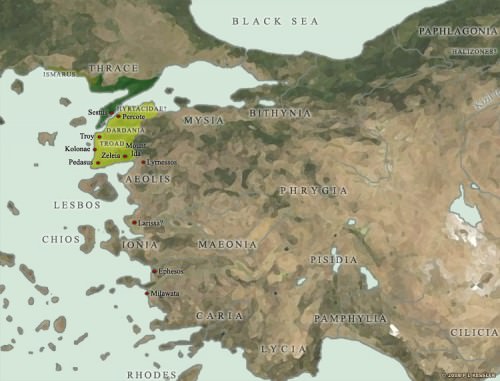
Map of the Trojan War States, c. 1200 BCE
Book 2 – Catalogue of Ships
Agamemnon rashly tries to storm Troy without Achilles, thus making himself even more unpopular with his men. There is a catalogue of ships which lists all the cities taking part in the war. It is long and impressive.
HELEN TO HECTOR: 'ON US TWO ZEUS HAS SET A DOOM OF MISERY, SO THAT IN TIME TO COME WE CAN BE THEMES OF SONG FOR MEN OF FUTURE GENERATIONS' (6:357)
Book 3 – The Revenge of Menelaus
'Godlike' Paris challenges Menelaus, 'master of the war-cry,' to a one-on-one fight to settle the war there and then. Helen bites her fingernails from the walls of Troy as Paris, wearing slightly flashy and inappropriate armour, is soundly beaten, but 'quick-glancing' Aphrodite steps in and whisks off the prince in a cloud. The war does not end this day.
Book 4 – Zeus Decides Troy's Fate
The gods argue about the progress of the war, but Athena and Hera insist that Troy must be destroyed. Zeus consents, but in return, he will destroy cities of his own choosing and at his own leisure - Mycenae will be one of them. Meanwhile, the two armies clash and the plains run with rivers of blood.
Book 5 – Apollo Repels Diomedes
The fighting continues, and the mighty Greek Diomedes kills all before him. The hero even attacks Aphrodite and Ares, but he finds himself no match for Apollo, the 'far-shooter,' in a scene which reminds of the unbridgeable gulf between gods and men.
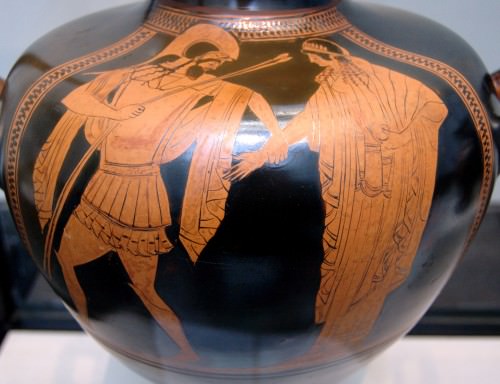
Menelaos & Helen
Book 6 – Humanity in War
The fighting on the plains continues and Diomedes meets Glaucus, but instead of fighting, these two champions have a chat and realise they are of mutual descent. They exchange some gifts of armour and part as friends, a little oasis of humanity in the pitiless desert of war. Meanwhile, inside Troy, we meet Hector's wife Andromache to remind us that the Trojans are not dissimilar to the Greeks and their women are equally worried for the future.
HECTOR: 'AND PEOPLE WILL SAY, EVEN MEN OF GENERATIONS NOT YET BORN, AS THEY SAIL BY OVER THE SPARKLING SEA IN THEIR MANY-BENCHED SHIPS: “THIS IS THE MOUND OF A MAN WHO DIED LONG AGO. HE WAS THE GREATEST OF MEN, & GLORIOUS HECTOR KILLED HIM”.' (7:71)
Book 7 – Hector vs. Ajax
Hector, 'tamer of horses,' son of king Priam and greatest Trojan warrior, challenges any Greek to combat. Agamemnon persuades Menelaus not to accept, and instead, Ajax, having drawn lots for the honour, marches out to meet the prince. The pair clash but without a decisive blow, and Ajax proves the master. Darkness then calls a halt to the fight and they part, once again loaded down with gifts. The next day a truce is called so that the dead can be gathered and cremated.
Book 8 – Hector Drives the Greeks Back to their Camp
Slightly fed up that the war has not ended by now, Zeus absolutely forbids the gods to intervene this day. Hector is magnificent and leads his army in a rousing charge which pens the Greeks back behind their fortified camp by the shore. Hector camps his army outside the city, such is his confidence in total victory the next day.
Book 9 – Achilles Refuses Agamemnon's Appeal
Things look so bad that Agamemnon considers throwing in the towel and sailing home, but he is persuaded to try and tempt Achilles to rejoin the fight by offering him a mass of treasure. Odysseus (wily king of Ithaca and especially smooth talker) leads Phoenix and Ajax who all tell Achilles to think of the men, their suffering, and the glory he can win. Achilles refuses and now loses the moral high ground. His pride will cost many lives.
Book 10 - Reconnaissance
A sort of intermission where both sides hold a meeting and decide to send spies into the enemy camp to check out their positions and weaknesses.
Book 11 – The Battle Ebbs & Flows
The Greeks come out of their camp fighting as never before and drive the Trojans back to Troy, but then the tide swings and the Greeks are forced to retreat with many wounded, including Agamemnon and Odysseus.
ARES GOD OF WAR: 'CALLED TERROR & PANIC TO YOKE HIS HORSES WHILE HE HIMSELF PUT ON HIS GLEAMING ARMOUR' (15:113)
Book 12 – The Greek Camp is Breached
The Trojans, with Hector and Sarpedon leading the way, break down the walls and smash the gate of the Greek camp. The Greeks panic and flee for their ships.
Book 13 – Poseidon Intervenes
The Greeks receive the help of Poseidon, the 'Earth-Shaker,' and they drive back the Trojans, wounding many and killing even more, including Ascalaphus, the son of Ares no less.
Book 14 – Hera Seduces Zeus
To keep the momentum with the Greeks, Hera, with the help of Aphrodite, distracts and seduces Zeus on Mt. Ida. Hector, meanwhile, is injured by a rock thrown by the now less-than-friendly Ajax.
Book 15 – Hector's Finest Hour
Zeus awakens to see the Trojans in peril and forbids any more intervention from Poseidon. Apollo joins the fighting, and with his help, the Trojans once more drive the Greeks back into their camp. Hector, enjoying his best day of the war, leads his men to the ships and calls for fire to set them all ablaze.
NARRATOR: 'AS HE SPOKE THE END OF DEATH ENFOLDED HIM: & HIS SPIRIT FLITTED FROM HIS BODY & WENT ON THE WAY TO HADES, WEEPING FOR ITS FATE.' (16:855)
Book 16 – Death of Patroclus
A key book. Patroclus, best friend of Achilles, remembers the advice of Nestor and begs the great warrior to join the fighting and, if not, then allow him to lead the fearsome Myrmidons wearing Achilles' armour. Achilles consents and the fate of his friend and his own is now sealed. The Myrmidons manage to put out the fire amongst the ships, and Patroclus even kills Sarpedon but then rashly charges the Trojans back to Troy. Apollo intervenes and strikes the hero's armour from his body, and he is killed by the spear of Hector. Now Achilles will be really angry. Troy's fate is also sealed this day.
Book 17 – The Body of Patroclus
The two sides fight for the body of Patroclus, but the Trojans win and strip his body. Hector dons the armour of Achilles, but the Greeks renew their efforts and finally manage to take the naked corpse back to their camp for proper burial.
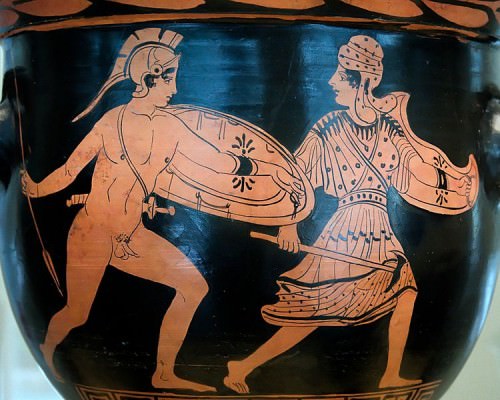
Achilles & Penthesileia
Book 18 – The Armour of Achilles
Achilles is told of the death of his friend and is predictably livid. He swears revenge on Hector. To fight, though, he needs armour, and this is promised him by his mother Thetis who enlists the master craftsman god Hephaistos. There follows a lengthy description of Achilles' new shield which is decorated with a myriad of fantastic scenes.
Book 19 – Achilles' Death is Foretold
Agamemnon and Achilles are reconciled and everyone has a big feast before the big battle of the 'morrow. Achilles knows now that he will die, and it will be at the hands of Paris and Apollo, but revenge drives him on undeterred.
APOLLO: '...WRETCHED MORTALS, WHO ARE LIKE LEAVES – FOR A TIME THEY FLOURISH IN A BLAZE OF GLORY, & FEED ON THE YIELD OF THE EARTH, & THEN AGAIN THEY FADE LIFELESS' (21:462)
Book 20 – The Gods Take Sides
Zeus calls for the gods to take their places in the coming battle. Ares, Artemis, Aphrodite, and Apollo will aid the Trojans while the Greeks have Hera, Poseidon, Hermes, and Athena. Battle commences on the plains. Achilles sweeps all before him, but Hector is saved from a confrontation by Apollo who whisks him away in a cloud.
Book 21 – Achilles & Xanthos
Achilles is still chopping away at the Trojans and bags himself 12 captives to slaughter later at the funeral of Patroclus. He drives so many of the enemy into the river Xanthos that the river god rises in indignation and chases Achilles back to the Greek camp. The gods begin fighting each other in a painless and inconsequential parody of the more brutal battle on the plain. Meanwhile, the Trojans are driven back, and all flee into their city, all except one: Hector, who makes a stands at the Skaian Gates.
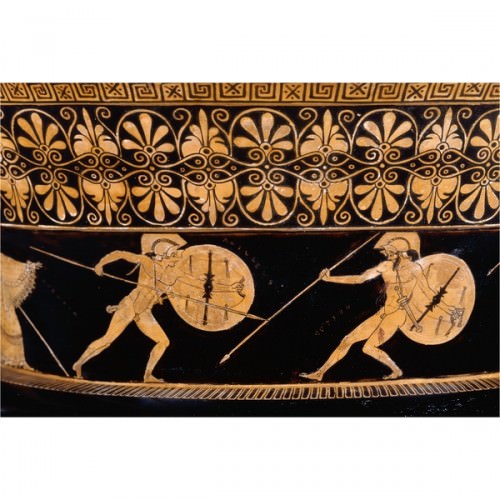
Achilles Fighting Hektor
Book 22 – Achilles vs. Hector
Hector, blaming himself for his own stupidity and camping out on the plains instead of safely inside the city walls, prepares to meet his fate. Priam bites his fingernails from the walls of Troy as he sees Achilles approach in his gleaming armour. The sight of the great warrior speeding towards him causes Hector to flee, and the pair indulge in a chase around the city three times.Zeus then weighs the golden scales of Fate and Hector's side sinks. 'Swift-footed' Achilles catches his man and sends him to Hades with a single spear strike to the throat. Now Troy really is in trouble. Shockingly, Achilles ties the body of Hector to his chariot and drags him ignominiously back to camp.
ACHILLES: 'THIS IS THE FATE THE GODS HAVE SPUN FOR POOR MORTAL MEN, THAT WE SHOULD LIVE IN MISERY, BUT THEY THEMSELVES HAVE NO SORROWS' (24:525)
Book 23 – Funeral Games for Patroclus
Having got his revenge, Achilles now sets about honouring Patroclus with some funeral games which include chariot races and prizes for all the winners. It is a break for everyone before the emotional drama of the final book.
Book 24 – Priam's Appeal
The gods are angry at Achilles' disrespect for the body of Hector. Thetis is sent to appeal to him. At the same time, Priam is helped by Hermes to magically appear in the Greek camp on his own mission of mercy. Achilles bows to Priam's moving speech and releases the body of Hector for proper burial. Here the Iliad ends.
What Happens Next
The demise of Hector is Homer's metaphor for the fall of Troy itself as the Iliad 's story ends here, if not the actual war. We still have to come battles with Amazons and the death of Achilles, felled by an arrow to his heel from Paris' bow. Paris is shot by Philoctetes, and Ajax goes mad and slaughters a load of sheep before committing suicide after not getting the armour of Achilles. Then, after the Trojan Horse ruse to gain entry into the city, Troy finally falls and is ruthlessly sacked.
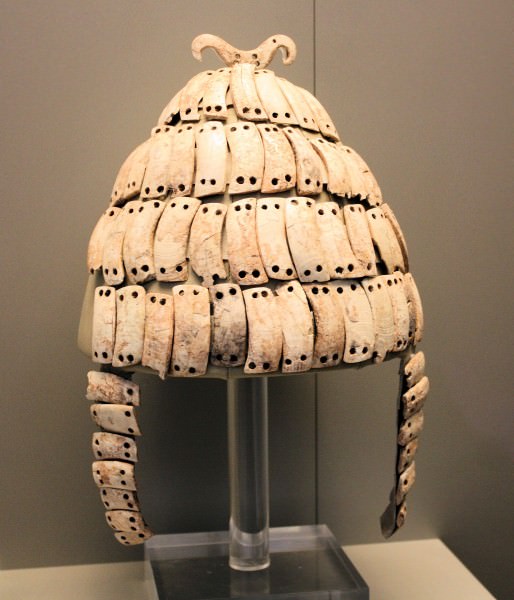
Mycenaean Boar's Tusk Helmet
MYTH & REALITY
The archaeological site of Troy in Anatolia, first excavated by Heinrich Schliemann in the late 19th century CE, has revealed a city with a history of habitation over thousands of years. Of the several cities built on top of each other, Troy VI (c. 1750-1300 BCE) is the most likely candidate for the besieged city of the Iliad. Impressive fortification walls with several towers certainly fit the Homeric description of 'strong-built Troy.' The lower town covers an impressive 270,000 m² and suggests a grand city like the Troy of tradition. Bronze arrowheads, spear tips, and slingshots have been found at the site and even some embedded in the fortification walls, suggesting some sort of conflict. These date to around 1250 BCE which correlates with the traditional date for the Trojan War.
Conflicts over generations between the Mycenaean and Hittite civilizations are more than probable, colonial expansion and control of lucrative trade routes being prime motivators. While such conflicts are unlikely to have been on the scale of Homer's war, collectively, they may well have been the origin of the epic tale of the Trojan War which has fascinated for centuries.
Mycenaean Pottery › Antique Origins
Ancient Civilizations
The pottery of the Mycenaean civilization (1550-1050 BCE), although heavily influenced by the earlier Minoans based on Crete, nevertheless, added new pottery shapes to the existing range and achieved its own distinctive decorative style which was strikingly homogenous across Mycenaean Greece. Mycenaean wares typically display stylized representations of marine and plant life and show a fondness for minimalistic linear designs, a trend which would go on to influence the early pottery of Archaic and Classical Greece from the 9th century BCE.
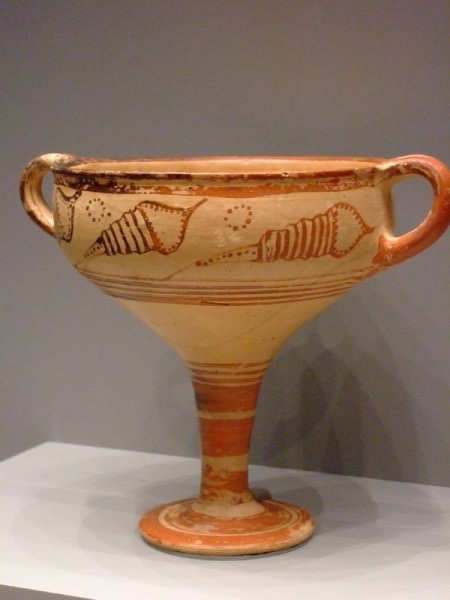
Mycenaean Stemmed Cup
MINOAN ORIGINS
Early wheel-made Mycenaean pottery (1550-1450 BCE) from mainland Greece has been described as 'provincial Cretan' which does convey the fact that although shapes and decorative styles were of Cretan origin, the final decoration was not quite as finely executed as in Minoan centres such as Knossos and Phaistos. However, despite this difference in quality, it is likely that Cretan potters did actually relocate to the mainland. In terms of raw material though, Mycenaean pottery is in fact often superior in quality to Minoan as the majority was made from old Yellow Minyan Clay and fired at higher temperatures than on Crete. The designs themselves were painted using a red to black, lustrous, iron-based clay slip (or 'paint') which had a tendency to become mottled depending on the firing process.
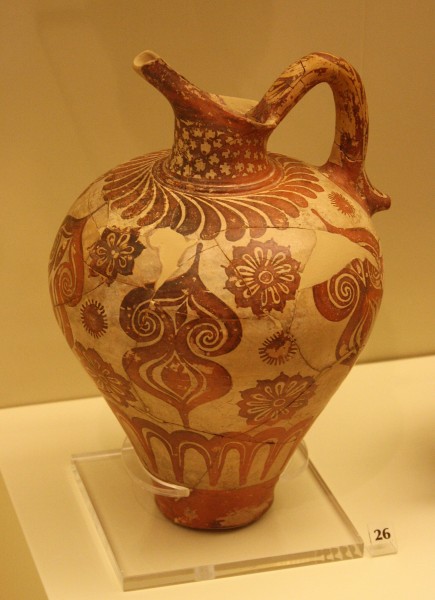
Mycenaean Jug
The Minoan love of flowing shapes and vibrant representations of animal, sea and plant life as expressed in their Marine and Floral styles was continued by the Mycenaeans with octopuses and nautiluses remaining particularly popular. Designs also continued to fill all of the decorative surface and follow the contours of the vessel. Gradually though, representations became more stylistic and more symmetrical with not all of the decorative space filled, leaving significant blanks, something rarely seen in Minoan pottery. Depictions of plants such as lilies, palms and ivy became more monumental, evolving into commonly employed motifs that were reserved principally for large jars.
From 1450 BCE the Mycenaean expansion overseas resulted in the taking over of the Cretan palaces and Mycenaean pottery began to dominate production across Greece and the Aegean islands. Indeed, pottery is the most important indicator we have of the political domination of the Mycenaeans across the Aegean. Decoration may be divided into two broad groups: the Pictorial style and the Pattern style. The former was influenced by contemporary fresco design and sought to represent scenes of daily life and the latter employed decorative scales, chevrons, and sea-life. Designs steadily became even bolder and more stylized, often with only a single motif design on each side of the vessel and an increase in the space left blank. Perhaps the most celebrated example of this minimalist style is the Ephyrean goblet, a stemmed, two-handled cup from Mycenae which is decorated with a single large rosette on each face. Plain, bold horizontal lines and whorls continue to be very popular forms of decoration and are usually well-chosen to complement the shape of the vessel.
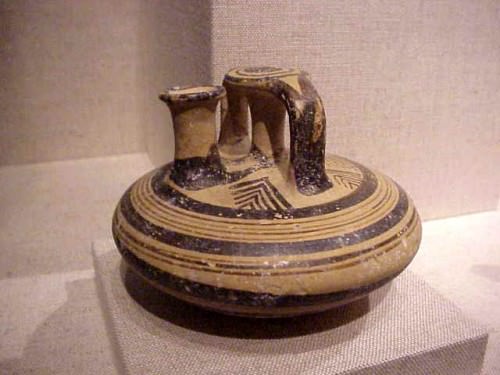
Mycenaean Stirrup Jar
POPULAR VESSELS
Vessel forms also evolve, for example with stemmed cups the stems becoming longer and the bowls shallower over time. New types of vessel were produced such as one-handled teacups, tankards and jugs with vertical strap handles and either spouts or cut-away necks. The most popular Mycenaean vessel was the strirrup jar, so called because the handle resembles a double stirrup. The centre of the handle was often decorated to look like a spout whereas the true spout was in fact to the side and separate from the handle. Stirrup jars had first appeared on Crete in the 16th century BCE but they became much more common from the 14th century BCE, came in all sizes and were usually used to store wine and oils.
POTTERY WAS USED BY ORDINARY PEOPLE WHO WERE UNABLE TO AFFORD THE MORE COSTLY METAL VERSIONS FOR THEIR EVERYDAY NEEDS.
The second most popular vessel shape was the alabastron, a squat jar of various sizes, so named because the early examples were made from alabaster. The form first appeared in the 15th century on the Greek mainland and typically they have three small ribbon handles near the neck. Alabasta vessels were probably used to store unguents.
Some clay vessels were tin-plated, perhaps to imitate more costly silver items. In addition, many designs, in particular whorls, were most probably copied from metal vessels. Both of these facts illustrate that pottery was used by ordinary people who were unable to afford the more costly metal versions for their everyday needs.
THE EVOLUTION OF DESIGN
Over time, Mycenaean pottery decoration continued to become more and more abstract to the point where it is sometimes difficult to identify the original subject. The evolution of the octopus in pottery design is an excellent indicator of the changing style. An early octopus is more or less accurately represented and its twisting tentacles with detailed suckers randomly cover all of the vase but gradually they become more formal with tentacles painted symmetrically on either side of the body and finally the tentacles become mere lines, impossibly long in relation to the body size and usually fewer than eight are depicted.
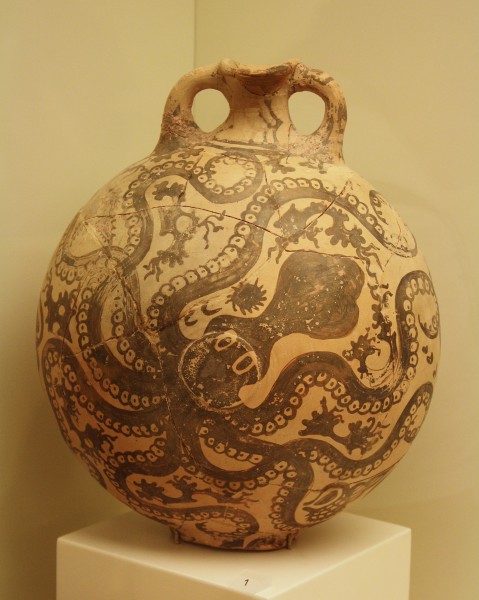
Minoan Vase in Marine Style
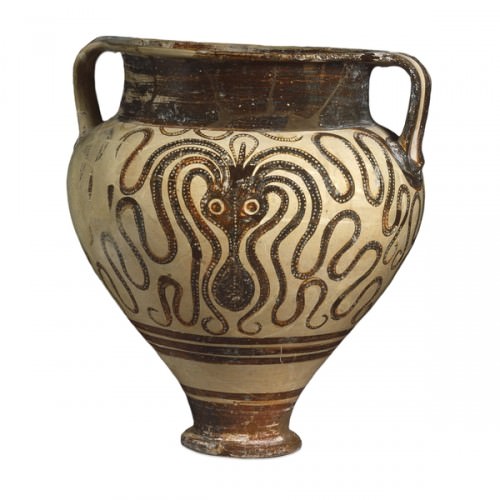
Mycenaean Vase Decorated With An Octopus
Dark bands of varying width become the principal form of decoration and only the space near the neck of vessels is used for pictorial representations. Particularly popular were chariot scenes which also included human figures, something extremely rare in Minoan pottery. Sacral knots, double axes and tusked helmets were popular subjects as were animals, birds and griffins, often arranged heraldically and themselves decorated with pattern designs, possibly imitating contemporary textile designs. An excellent example of this technique can be seen in the bull and bird decorated vase from the British Museum where the bodies are divided into sections, each decorated differently with dots, wavy lines, scales, crosses or chevrons. This vessel shape - the deep bowl - became very popular from the 13th century BCE and there are rare examples of white decoration on a dark background.
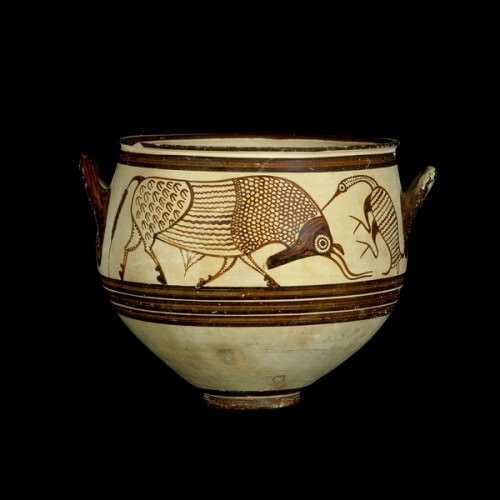
Mycenaean Vase Decorated With Bulls & Birds
From the 12th century BCE greater regional variety is seen in pottery design and decoration, perhaps reflecting the political instability of that period as evidenced by settlement destructions. Designs may now be categorized into four broad groups. The first is the Closed style (of Cretan influence but originating in the Argolid) where all of the vessel or a designated area of it is filled with various patterns, usually rosettes and birds. The Fringed style mixes bold curves or lines with fringes and more detailed secondary decoration of fine lines in abstract patterns. The evolution of designs with octopuses is a sub-group of this style. The Pictorial style continues and a celebrated example is the Warrior Vase from Mycenae which depicts eleven marching warriors with spears and each carrying a bag, perhaps containing their daily food rations. A woman, standing to one side, bids them farewell. Interestingly, this would become a common theme in 4th to 5th century BCE Greek pottery. Finally, there is the Granary style which either displays a minimalistic decoration with only a few bands or wavy lines or in some cases the entire vessel is decorated in a monochrome slip or left completely undecorated. This rather poorer style was a precursor to the cruder sub-Mycenaean pottery prevalent from the 11th century BCE.
FIGURINES, SARCOPHAGI & RHYTA
Clay figurines have been found at sites across the Mycenaean Empire dating from the 14th to 12th centuries BCE and are remarkably similar in design. Highly stylized to the point of being almost unrecognisable as human forms, the figures are most commonly female and standing. Often these figures have two arms raised or crossed in front of the chest, a long skirt and a conical headdress. They are simply decorated with bold lines and sometimes jewellery is also painted on the figure using simple dots. There are also several examples of figurines depicting a woman clutching a child. Most probably these clay figures represent a nature goddess of Cretan origin as several have been found in a shrine context but other suggestions as to their function range from votive dedications to children's toys. On Crete, always a little different in their pottery, figurines during the Mycenaean period most commonly took the form of a large female figure (as tall as 75cm) with a hollow cylindrical lower half of the body and with raised arms. From 1200 BCE clay animal figures were also popular. Made on the wheel and with limbs and heads made by hand, they are simply decorated with lines and dots.
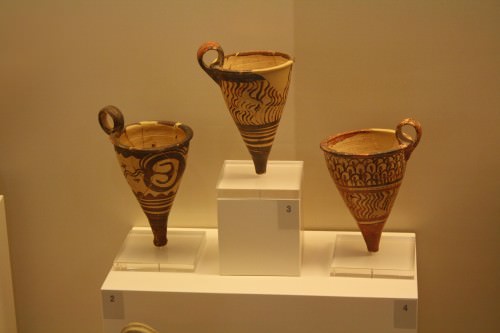
Mycenaean Rhyta
Clay sarcophagi had been widely used by the Minoans to bury their dead and they usually took the form of either a chest with short legs or a bath-tub and were decorated in much the same manner as pottery vessels. On Crete this tradition became even more popular in the Mycenaean period but examples elsewhere in the Mycenaean Empire are limited to a cemetery at Tanagra in Boeotia (1400-1200 BCE). Clay was also used to make rhyta - vessels used for pouring libations and ceremonial drinking during religious ceremonies. These are most commonly in a conical form and are decorated as contemporary pottery vessels.
THE MYCENAEAN LEGACY
Mycenaean pottery was exported and imitated not only throughout the Aegean but also in places as far afield as Anatolia, Syria, Egypt and Spain. There is also evidence that Mycenaean potters actually relocated and set up workshops abroad, particularly in Anatolia and southern Italy. Indeed, it may well be that designs of a Mycenaean origin introduced into these areas lived on to be re-introduced back to mainland Greece once the so-called Dark Ages had ended. This three century decline in all areas of culture but particularly in arts and crafts would, therefore, not be an end but only an interruption in the evolution of Greek culture. Pottery design would once more flower again with the geometric pottery of the 8th century BCE which certainly owed a great debt to the highly stylized pottery decoration so loved by the Mycenaeans.
LICENSE:
Article based on information obtained from these sources:with permission from the Website Ancient History Encyclopedia
Content is available under License Creative Commons: Attribution-NonCommercial-ShareAlike 3.0 Unported. CC-BY-NC-SA License